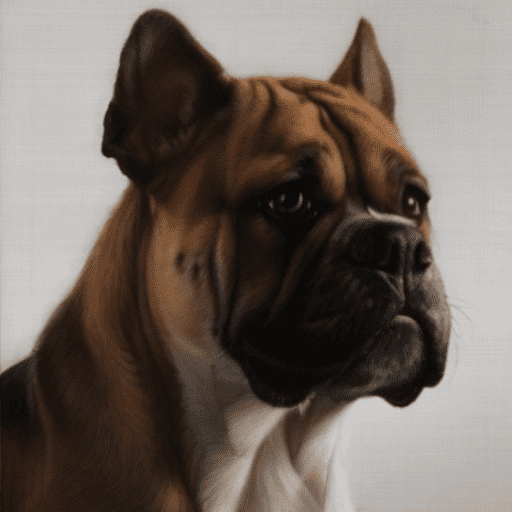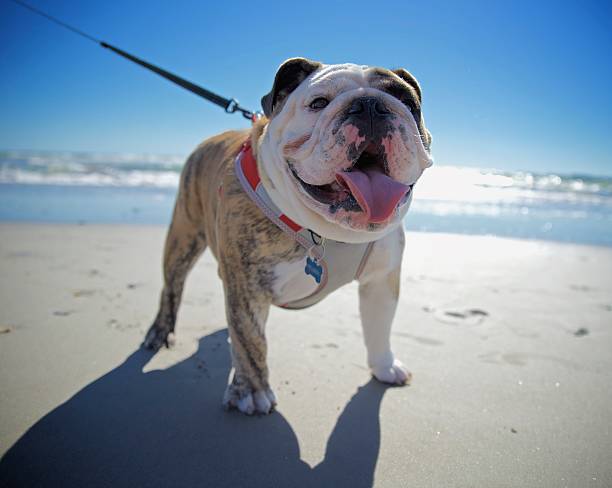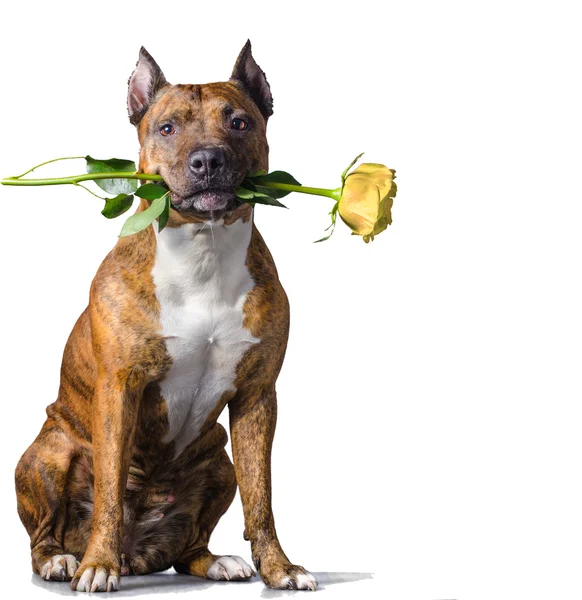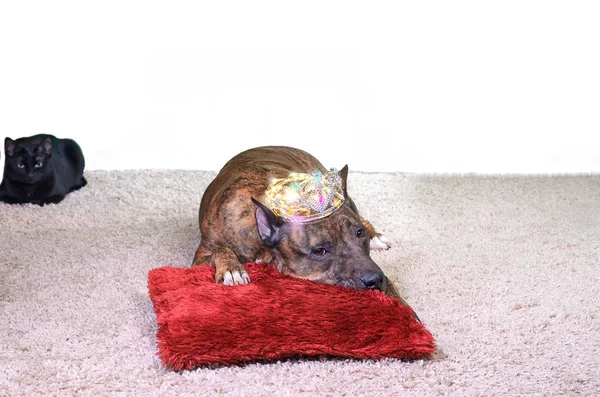The Spanish Bulldog, also known as the Alano Español, is a majestic emblem of strength, loyalty, and protective instincts, capturing the hearts of dog lovers and families seeking a noble companion. With its powerful build, gentle demeanor, and unwavering dedication, this breed has earned its place as a cherished guardian and a tribute to its Spanish heritage.

| Category (Explanation) | Breed Information |
|---|---|
| Year of Breed Conception | Ancient |
| Country of Origin | Spain |
| Weight (Male) | 75-100 lbs (34-45 kg) |
| Weight (Female) | 60-85 lbs (27-39 kg) |
| Coat Type | Short, smooth |
| Color Variations | Various, including brindle and black |
| Shedding Level | Low to moderate |
| Height (cm & in) | 58-64 cm (23-25 inches) |
| Breed Size | Large |
| Trainability | Moderate |
| Mental Needs | Moderate |
| Intelligence Level | Moderate |
| Energy Level | Moderate to high |
| Agility | Moderate |
| Loyalty | High |
| Playfulness | Moderate to high |
| Exercise Needs | Regular exercise and play |
| Guarding Proficiency | High |
| Sociability with Children | High |
| Barking Level | Low to moderate |
| Digging Tendency | Low to moderate |
| Destructive Behavior | Low to moderate |
| Drooling Level | Moderate |
| Obedience Level | Moderate |
| Apartment Friendly | Yes, with proper exercise and space |
| Inherent Prey Drive | Moderate |
| Physical Risk to Others | Low to moderate |
| Travel Fatality Risk | Low |
| Allergen Potential | Low (considered hypoallergenic) |
| Health Concerns | Hip dysplasia, joint issues |
| Average Life Expectancy | 10-12 years |











































































Woof Mastery is reader supported and our articles may contain affiliate links.
Instead of running third party ads that we have no control of we only use links from high-quality companies we are directly partnered with. Making use of these links come at no cost to you our reader, and in many cases have the extra benefit of discounted rates or sign up bonuses.
If you’re interested you can read more about our affiliate policy here.
We appreciate your support and always insure that the products and services we recommend are high-quality, helpful and relevant to the subject at hand!
The Spanish Bulldog, known as the Alano Español, boasts a rich history in Spain. Originating in the Iberian Peninsula, these dogs have been cherished for centuries for their strength and versatility. They were used for hunting, herding livestock, and as loyal protectors. The Alano Español’s journey reflects their adaptability and tenacity, as they transitioned from working dogs to beloved family companions.
Today, they are celebrated for their strength, loyalty, and their deep connection to Spanish culture, symbolizing the enduring spirit and charm of the Iberian Peninsula.

What sets the Spanish Bulldog, or Alano Español, apart is it special history as a versatile working dog. Originating from Spain, these dogs are known for their strength and loyalty. Spanish Bulldogs combine their impressive physical abilities with a deep devotion to their families, making them exceptional working partners and beloved companions.
The traditional role of the Spanish Bulldog included hunting, herding, and guarding. Their strength and determination made them reliable working dogs, capable of facing challenging tasks. Today, they continue to excel as loyal family companions, offering both protection and affection to their loved ones.
Spanish Bulldogs, or Alano Españols, are renowned for their confident and courageous personalities. They are fiercely loyal, deeply affectionate, and incredibly protective of their families.
These dogs have a strong sense of duty and an innate intelligence that makes them adaptable and trainable. Spanish Bulldogs are known for their unwavering loyalty and their ability to form deep connections with their family members. They take their role as protectors seriously and are always ready to defend their loved ones.
While they may be reserved around strangers, they form unbreakable bonds with their owners and will fiercely protect them when needed. Spanish Bulldogs embody the ideal combination of strength and affection, providing both protection and a strong sense of devotion to their family.
Spanish Bulldogs, or Alano Españols, often possess a loyal and protective temperament. They may exhibit affection towards their families while displaying protective instincts that necessitate proper training and socialization to avoid overprotectiveness. Territorial behavior and occasional stubbornness can be managed with consistent and patient training methods.
Due to their strength and size, leash training is crucial. Careful introductions are advised when interacting with other dogs, especially those of the same sex. Early training and socialization are fundamental for nurturing a well-adjusted and balanced temperament in this breed. Spanish Bulldogs are known for their devotion and protective nature.
Spanish Bulldogs, also known as Alano Español, are medium to large-sized dogs celebrated for their muscular and imposing build. They possess a square-shaped head with a broad, well-defined jaw and powerful cheeks, giving them a commanding presence.
Their eyes are typically brown. Ears are medium-sized and can be cropped or natural. These dogs have a short, smooth coat, often seen in various shades of brindle or fawn. The coat accentuates their powerful physique. Spanish Bulldogs feature a muscular neck, leading to a broad chest and sturdy, straight legs. The tail is usually straight.
In terms of size, males typically stand between 22 to 25 inches (56-64 cm) at the shoulder, while females are slightly smaller. Weight ranges from 80 to 110 pounds (36-50 kg) for males, with females being lighter.
Overall, Spanish Bulldogs project a powerful and imposing presence, reflecting their history as versatile working and hunting dogs. Their appearance exudes strength, loyalty, and confidence.
Spanish Bulldogs, also known as Alano Español, have a strong and muscular appearance with several color varieties, including:
Spanish Bulldogs, also known as Alano Español, have a low shedding level. They are not heavy shedders, and their shedding is typically minimal year-round. Occasional grooming and brushing with a soft bristle brush can help manage shedding and maintain their coat’s health.
Factors that affect shedding in Spanish Bulldogs can be influenced by genetics and overall health. Regular exercise, a balanced diet, and providing mental stimulation are essential for overall health and coat care, potentially reducing shedding.
Spanish bulldogs, a testament to power and agility, sports a coat that’s firm and close-fitting.
Brushing: Their minimal coat still requires weekly care. Using a rubber mitt, followed by a soft-bristle brush, can aid in shedding management and ensure the removal of any environmental allergens.
Bathing: Their bath routine should be spaced every 6-7 weeks. Using a gentle, hypoallergenic shampoo, followed by a moisturizing conditioner, can keep their coat and skin in pristine condition.
Ears: Being medium-sized, their ears can trap debris. Regular cleaning, preferably weekly, with a mild cleaning solution, is vital.
Nails: Their robust physique demands well-maintained paws. Bi-weekly trimming, complemented with a monthly filing, is recommended.
Teeth: To counter potential dental ailments, daily brushing, combined with dental treats and periodic professional cleanings, can be beneficial.
Wrinkle Care: The breed’s minimal wrinkles, predominantly around the neck, can trap moisture. Regular cleaning and drying are vital.
Eye Care: Their deep, almond-shaped eyes need daily checks. Using a damp cloth for cleaning and keeping an eye out for any signs of irritation can be beneficial.
Spanish Bulldogs, also known as Alano Español, have a moderate activity level. They are known for their strength and versatility. Here are some key points to consider about their activity level:
The Spanish Bulldog, known as the Alano Español, boasts a moderate level of intelligence, characterized by adaptability, problem-solving skills, and a strong inclination to please their owners. Here are key characteristics highlighting their intelligence:
Spanish Bulldogs have some intelligence, especially in their adaptability, problem-solving skills, and loyalty. They excel as both versatile working dogs and loving family companions. Training, socialization, and mental stimulation are essential for them to reach their full potential.
Spanish Bulldogs, or the Alano Español, with their sharp intellect, thrive on mental challenges. Engaging them in tracking exercises, complex toys, or herding drills keeps them stimulated.
Social Interaction: Their historically protective nature necessitates consistent bonding moments with family. Extended solitude can manifest as restlessness.
Exercise: Engaging in regular physical endeavors not only strengthens their frame but also elevates their cognitive health. Activities that tap into their herding instincts are particularly beneficial.
Training and Obedience: Given their heritage as working dogs, structured training sessions mentally engage them and solidify the bond with their caregivers. Reward-based training is particularly effective.
Routine and Structure: A stable routine instills a sense of security and wards off potential anxieties.
Affection and Attention: While they may seem reserved, they need affectionate interactions and bonding moments with their caregivers to truly thrive.
Socialization: To balance their protective tendencies, early and varied social experiences are pivotal.
Safe Environment: Crafting a calm household atmosphere with a dedicated retreat space ensures they can relax when the need arises.
Consistency: Maintaining a consistent daily rhythm and training approach ensures they remain confident and well-adjusted.
Enter The Woof Mastery

Before bringing a Spanish Bulldog (Alano Español) into your home, it’s crucial to understand their needs. These dogs are known for their strength and loyalty. They require regular exercise and mental stimulation to thrive. Training and socialization are vital to harness their protective nature.
Health concerns, such as joint issues, should be monitored. Responsible ownership includes providing love, attention, and a safe environment for these devoted and courageous companions.
Spanish Bulldogs or the Alano Español, known for their historical roles in hunting and bull-baiting, have the potential to pose a physical danger if they aren’t properly socialized, trained, or managed. Behavior is influenced by factors such as temperament, upbringing, training, and owner involvement. Here’s their potential danger breakdown:
Spanish Bulldogs, or Alano Españols, are renowned for their confident and courageous personalities. They are fiercely loyal, deeply affectionate, and incredibly protective of their families.
These dogs have a strong sense of duty and an innate intelligence that makes them adaptable and trainable. Spanish Bulldogs are known for their unwavering loyalty and their ability to form deep connections with their family members. They take their role as protectors seriously and are always ready to defend their loved ones.
While they may be reserved around strangers, they form unbreakable bonds with their owners and will fiercely protect them when needed. Spanish Bulldogs embody the ideal combination of strength and affection, providing both protection and a strong sense of devotion to their family.
The Spanish Bulldog or Alano Español, historically a working breed, has certain attributes affecting its relationship with water. Here’s what to consider:
While some Spanish Bulldogs might enjoy water play or even a swim, it’s crucial to prioritize safety and be attentive to their comfort levels.
Spanish Bulldogs, known as Alano Español, like all canines, have their distinct set of sounds and vocalizations. Here’s what to expect:
For Spanish Bulldog owners, discerning the nuances behind their dog’s vocalizations and their reasons is crucial. While many are simply expressive, some might hint at discomfort or specific needs. Using positive reinforcement techniques can be an effective tool in guiding their vocal behavior.
Spanish Bulldogs, also known as Alano Español, thrive in homes where they receive love, structure, and opportunities for socialization. Here are some ideal living conditions for Spanish Bulldogs:
Challenges:
When it comes to travel fatality risk for the Spanish Bulldog or Alano Español, consider the following potential constraints:
By heeding these guidelines and maintaining precautions, you can ensure safer travels with your Spanish Bulldog.
Spanish Bulldogs may be prone to specific health concerns. While not all individuals will experience these issues, it’s essential for Spanish Bulldog owners to be aware of potential health problems and work with veterinarians to maintain their pets’ well-being. Common health concerns in Spanish Bulldogs include:
Regular veterinary check-ups, a balanced diet, proper exercise, and responsible breeding practices can help mitigate some of these health concerns. It’s crucial for Spanish Bulldog owners to work closely with their veterinarians to monitor their pets’ health and address any issues promptly.
For Spanish Bulldogs, also known as Alano Español, maintaining proper nutrition is vital for their health and well-being. Here are tailored nutritional habits and best practices for this breed:
Breed-Specific Laws (BSL): Spanish Bulldogs, commonly known as Alano Español, could occasionally be impacted by breed-specific laws (BSL) in particular locales. These laws are generally enacted at the city or local level and can differ by jurisdiction.
Types of Restrictions: Under BSL, Spanish Bulldogs might face obligations like mandatory spaying/neutering, specialized licensing, liability insurance requirements, muzzling provisions in public spaces, and in rare instances, ownership prohibitions, contingent upon local laws.
Rationale for BSL: BSLs typically stem from concerns about certain breeds, especially if linked to negative incidents. The Alano Español, renowned for its guarding and herding abilities, might face BSL scrutiny due to misconceptions about its nature.
Controversy: BSL remains a topic of debate, with many suggesting that these regulations can be overly broad. The emphasis, for many, is on individual behavior and responsible ownership over breed-specific measures.
Local Regulations: Before acquiring a Spanish Bulldog or Alano Español, it’s essential to check with local authorities and be well-informed about any potential breed-specific regulations.
Woof Mastery is reader supported and our articles may contain affiliate links.
Instead of running third party ads that we have no control of we only use links from high-quality companies we are directly partnered with. Making use of these links come at no cost to you our reader, and in many cases have the extra benefit of discounted rates or sign up bonuses.
If you’re interested you can read more about our affiliate policy here.
We appreciate your support and always insure that the products and services we recommend are high-quality, helpful and relevant to the subject at hand!
Myth 1: Spanish Bulldogs (Alano Español) are Aggressive by Nature
Myth 2: They are High-Energy Dogs
Myth 3: They Can’t Tolerate Cold Weather
Myth 4: They are Not Good with Children
Myth 5: They Shed Excessively
Myth 6: They Don’t Require Training
Myth 7: They are Always Good with Other Dogs
Myth 8: They Are All the Same Size
Myth 9: They are Unhealthy Dogs
Myth 10: They are Always Clingy
The Spanish Bulldog (Alano Español) holds cultural significance in various contexts:
While there may not be as many famous Spanish Bulldog owners as there are for other dog breeds, here are a few notable individuals who have been associated with Alano Español:
Spanish Bulldogs, or Alano Español, like many other dog breeds, have faced several threats and challenges over the years. Some of the significant threats and issues that have affected the breed include:
The Spanish Bulldog, or Alano Español, is believed to have been developed from a combination of various breeds, with the primary ancestors being the ancient Molosser dogs brought to Spain by invading tribes. The breed’s development has ancient roots, with influences from regional strains and breed types. The specific breeds and strains that contributed to the Spanish Bulldog’s development include:
Spanish Bulldogs, also known as Alano Español, are a unique blend of strength and loyalty, making them exceptional family companions. With their robust physique and loving disposition, they effortlessly integrate into our lives, becoming cherished members of our households.
These dogs excel as watchdogs, displaying protective instincts that further solidify their role as guardians of our homes. Spanish Bulldogs are known for their adaptability, thriving in various living conditions, and requiring only minimal grooming. Their athletic prowess and playful spirit cater to active individuals and families, making them excellent playmates. Their intelligence shines in activities and training.
Beyond their physical attributes, Spanish Bulldogs bring a unique charm to every household, filling the air with their presence. Their versatility is a testament to their adaptability, transitioning effortlessly from beloved family pets to diligent working dogs.
Most importantly, Spanish Bulldogs offer profound and unconditional love, forging an unbreakable bond that enriches our lives. If you’re seeking a loyal and affectionate companion, embrace the love and devotion of a Spanish Bulldog, also known as the Alano Español.